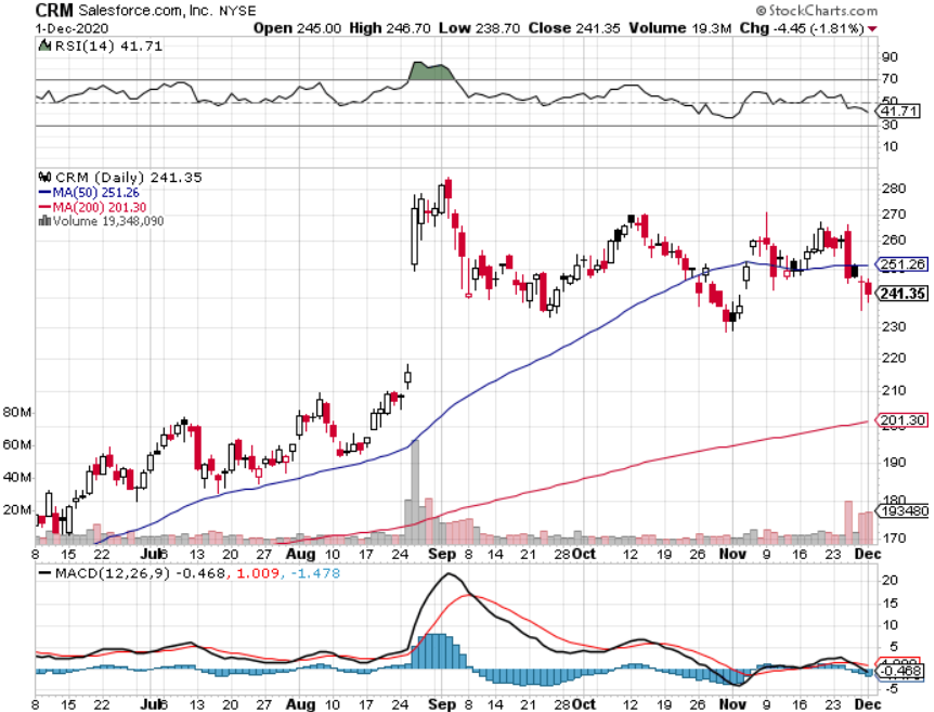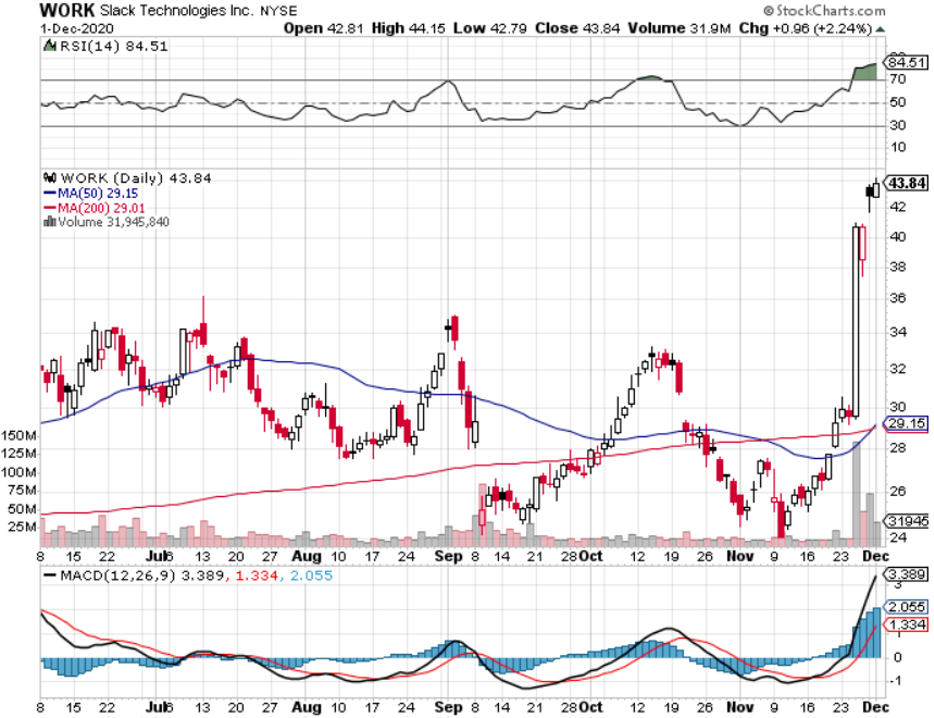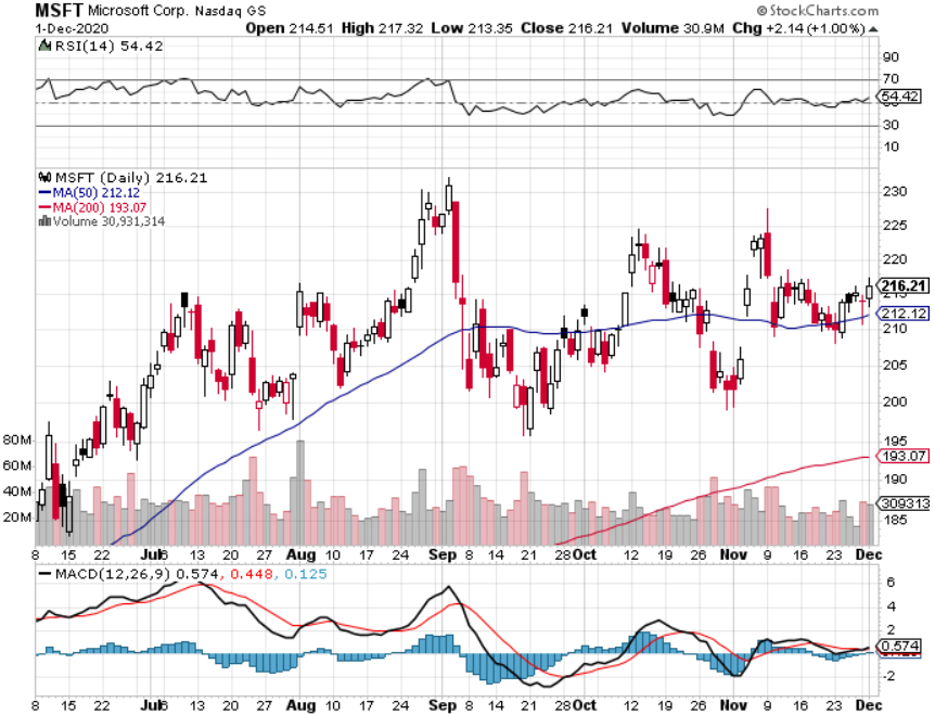This was basically a deal they had to do even though I believe Salesforce (CRM) massively overpaid for Slack (WORK).
The other option would be to fall even further behind Microsoft (MSFT) who has hit a home run with their own in-house iteration of Slack-ish software called Microsoft Teams.
In fact, this is the biggest acquisition in Salesforce’s software history and purchasing the software developer Slack for over $27 billion marks a new chapter in their history.
Through a combination of cash and stock, Salesforce is purchasing Slack for $26.79 a share and .0776 shares of Salesforce.
Other big software deals such as IBM’s $34 billion purchase of Red Hat in 2018, the largest in its history, followed by Microsoft’s $27 billion acquisition of LinkedIn in 2016 are also noteworthy.
Last year, the London Stock Exchange agreed to buy data provider Refinitiv for $27 billion, though the deal has yet to be cleared by European regulators.
Salesforce has decided to grow via M&A as CEO Marc Benioff hopes to stave off a growth downturn by pre-emptively addressing these potential problems.
His goal is to get more investors on board for the long haul.
In the short term, the jury is out on whether Salesforce can “grow into” the high valuation which they agreed to pay for Slack.
Other deals made by Salesforce are when the company spent $15.3 billion on data visualization company Tableau in 2019 and, a year earlier, they captured MuleSoft for $6.5 billion whose back-end software connects data stored in disparate places.
The future of enterprise software is transforming the way everyone works in the all-digital, work-from-anywhere world and Salesforce will be one of the leading voices in how this plays out.
Don’t forget that Salesforce started the enterprise cloud revolution, and two decades later, they are still tapping into all the possibilities it offers to transform the way we work.
For Slack, this is a major victory because they had begun to see the writing on the wall with two uninspiring earnings reports which signaled that Microsoft was having their cake and eating it too.
For Salesforce to pay a 30%-40% premium for Slack reveals the sense of desperation permeating into the ranks of Salesforce management.
Another takeaway is that enterprise software is putting their money where their mouth is convinced that the shelter-in-home economy will last long after the brutal public health crisis is over.
I tend to agree with this diagnosis, but I don’t agree with overpaying for Slack at the degree in which they did.
However, the climate of cheap rates and high liquidity feeds into the normalcy of overpaying for quality assets.
What’s so bad about Slack?
Slack has blamed the downturn in fortunes on some of its small business customers being hurt by the pandemic.
The company has loosened contract structures and extended credits to help them out which is a major red flag.
The slowdown has only fueled nervousness that Microsoft (MSFT) Teams’ ascent is weighing on Slack’s growth potential.
Teams now has more than 115 million users while Slack has a fraction of that, despite having the edge in the minds of most in terms of user interface.
Slack’s slowing growth, in turn, hurt its sentiment and ultimately its stock price.
Salesforce could have acquired Slack for a discount in a year or two, but by that time, Salesforce would be left in the dust.
Salesforce had to act with urgency even if Slack still expects to post a net loss this fiscal year. It’s unclear when Slack will turn a profit-making company even less attractive.
Salesforce will need to subsidize Slack’s losses for the time being.
What’s in it for Salesforce?
Salesforce could help easily scale up Slack to more high-paying corporate customers in a major challenge to Microsoft Teams which would vastly help Slack’s margins.
There are also numerous synergies in being under the Salesforce umbrella which would only strengthen the profit potential of the communications platform.
By acquiring Slack, a business chat service with over 130,000 paid customers, Salesforce is bolstering its portfolio of enterprise applications and filling out its broader software roster as it seeks additional growth engines.
Salesforce obviously believes that the sum of the parts will be greater than each individual segment and I agree.
Salesforce’s annualized revenue topped $20 billion in the fiscal second quarter, with growth of 29%. But the forecast for the full year of 21% to 22% growth would represent the company’s slowest rate of expansion since 2010.
Microsoft and Salesforce are direct rivals at this point and Salesforce is the dominant player in customer relationship management software, where Microsoft is a distant challenger. Both companies tried to buy LinkedIn, the professional networking site, but Microsoft was the ultimate winner.
The company’s core Sales Cloud product for keeping track of current and potential customers delivered $1.3 billion in revenue, up 12% year over year and that’s simply not good enough to be considered a “growth asset.”
Many investors won’t bite at the bid unless a burgeoning tech company is north of 20% and preferably plus 30%.
Salesforce will now embark on a narrative of engineering growth to fit its investors’ preferences, but I do hesitate to think that this will most likely mean continuing to overpay for software companies.
Salesforce does have the resources to absorb this pricey endeavor but is it sustainable when the likes of Microsoft, Google, and so on are competing for the same assets?
Does this mean that Twitter would be $60 billion in today’s climate?
That’s a scary thought.
M&A could disappear soon from tech because the valuations might reach some sort of peak that even cash-rich Silicon Valley firms might balk at.
Yes, we are getting to that stage of tech. Tech is becoming a luxury.
In the short term, buy Salesforce’s dip as some investors will sell as a way to signal to Salesforce that they aren’t happy with their capital allocation strategy and ultimately this isn’t a guarantee of adding growth and could possibly backfire in Benioff’s face.






